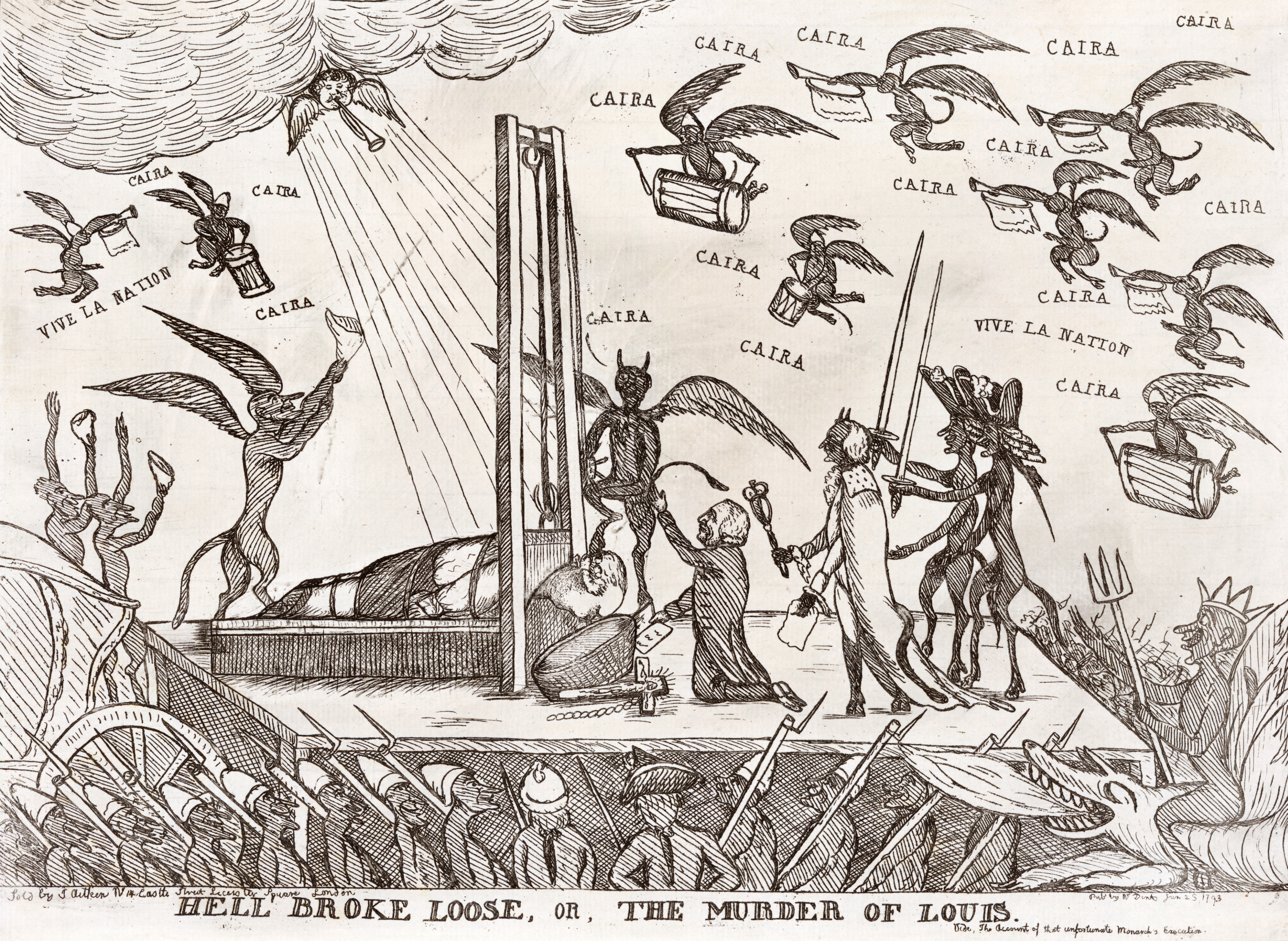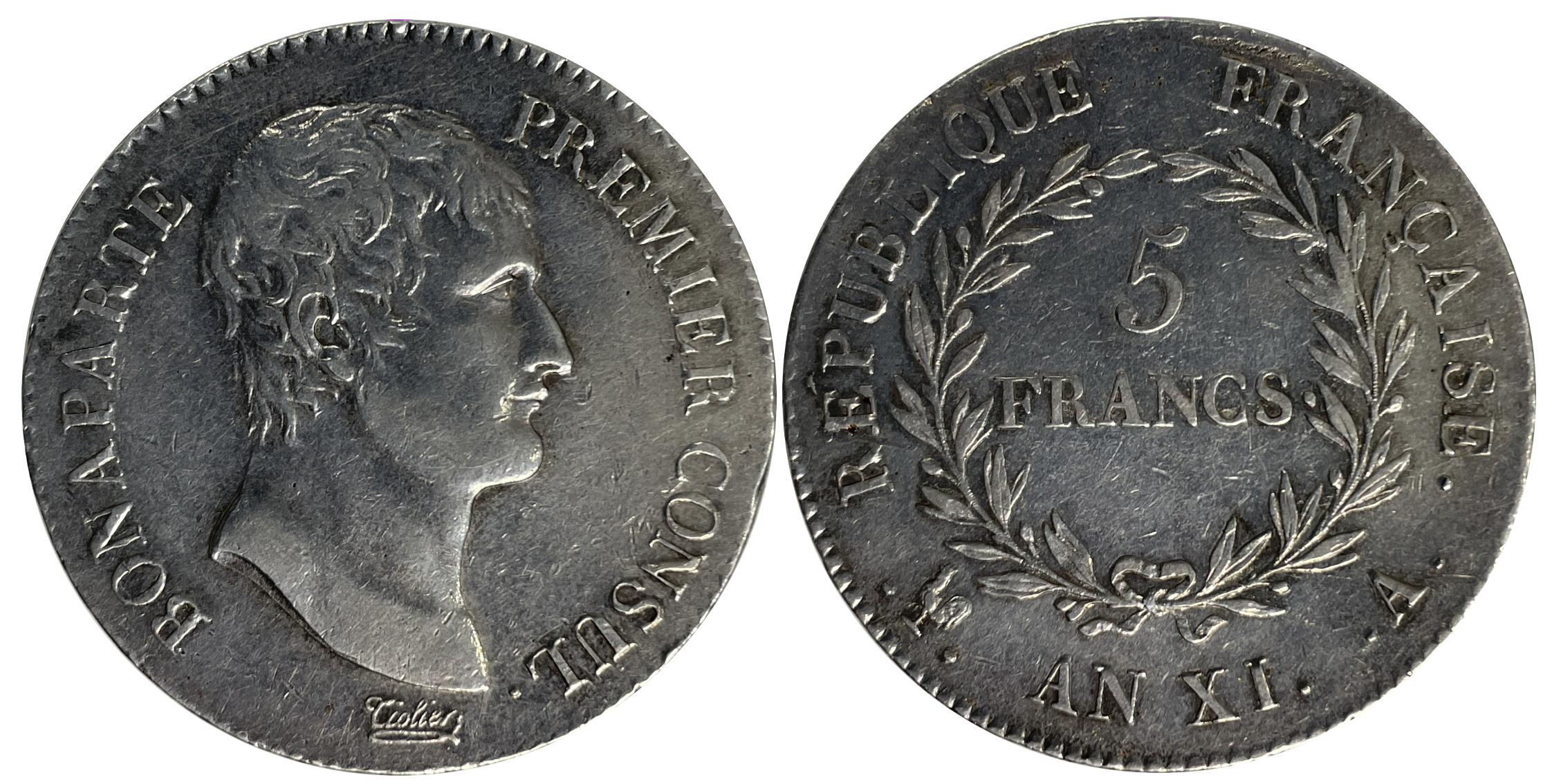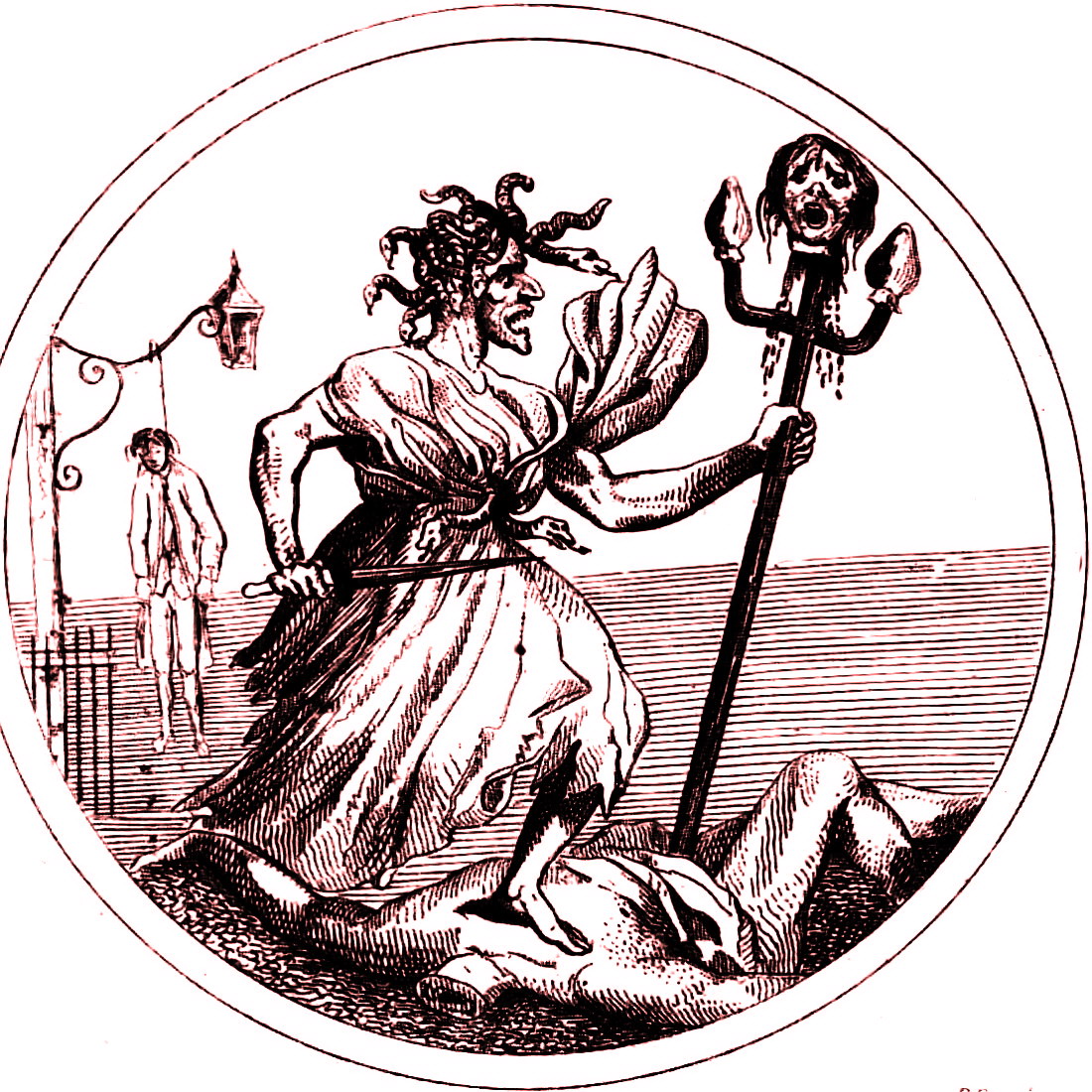|
Ça Ira
"" (; French: "it'll be fine") is an emblematic song of the French Revolution, first heard in May 1790. It underwent several changes in wording, all of which used the title words as part of the refrain. Original version The author of the original words "" was a former soldier by the name of Ladré who made a living as a street singer. The music is a popular contredanse air called "Le carillon national", and was composed by Bécourt, a violinist (according to other sources: side drum player) of the théâtre Beaujolais. Queen Marie Antoinette herself is said to have often played the music on her harpsichord. The title and theme of the refrain were inspired by Benjamin Franklin, in France as a representative of the Continental Congress, who was very popular among the French people. When asked about the American Revolutionary War, he would reportedly reply, in somewhat broken French, "" ("It'll be fine, it'll be fine"). The song first became popular as a worksong during the ... [...More Info...] [...Related Items...] OR: [Wikipedia] [Google] [Baidu] |
Hell Broke Loose, Or The Murder Of Louis, 1793
In religion and folklore, hell is a location in the afterlife in which evil souls are subjected to punitive suffering, most often through torture, as eternal punishment after death. Religions with a linear divine history often depict hells as eternal destinations, the biggest examples of which are Christianity and Islam, whereas religions with reincarnation usually depict a hell as an intermediary period between incarnations, as is the case in the dharmic religions. Religions typically locate hell in another dimension or under Earth's surface. Other afterlife destinations include heaven, paradise, purgatory, limbo, and the underworld. Other religions, which do not conceive of the afterlife as a place of punishment or reward, merely describe an abode of the dead, the grave, a neutral place that is located under the surface of Earth (for example, see Kur, Hades, and Sheol). Such places are sometimes equated with the English word ''hell'', though a more correct translatio ... [...More Info...] [...Related Items...] OR: [Wikipedia] [Google] [Baidu] |
Guinguette
The guinguette was a popular drinking establishment in the suburbs of Paris and of other cities in France. Guinguettes would also serve as restaurants and often as dance venues. The origin of the term comes from ''guinguet'', indicating a local sour, light white wine. The 1750 ''Dictionnaire de la langue française'' defined guinguette as a "small cabaret in the suburbs and the surrounds of Paris, where craftsmen drink in the summer and on Sundays and on Festival days. This term is new. It comes apparently from what is sold in these cabarets: a sour light local green wine, that is called ''ginguet'', such as found around Paris." A ''goguette'' was a similar kind of establishment. History During the 18th century, a consumer revolution led once isolated villages and hamlets outside Paris to be swept up in a booming material culture. Commodities, and particularly alcohol, consumed outside the customs barrier of the city were considerably cheaper, being exempt from state taxes. Th ... [...More Info...] [...Related Items...] OR: [Wikipedia] [Google] [Baidu] |
March (music)
A march, as a musical genre, is a piece of music with a strong regular rhythm which in origin was expressly written for marching to and most frequently performed by a military band. In mood, marches range from the moving death march in Richard Wagner, Wagner's ''Götterdämmerung'' to the brisk military marches of John Philip Sousa and the martial hymns of the late 19th century. Examples of the varied use of the march can be found in Ludwig van Beethoven, Beethoven's Symphony No. 3 (Beethoven), ''Eroica'' Symphony, in the Three Marches Militaires (Schubert), Marches Militaires of Franz Schubert, in the Marche funèbre in Frédéric Chopin, Chopin's Piano Sonata No. 2 (Chopin), Sonata in B flat minor, the "''Jäger March''" in the by Jean Sibelius, and in the Dead March in George Frideric Handel, Handel's ''Saul (Handel), Saul''. Characteristics Marches can be written in any time signature, but the most common time signatures are , (''alla breve'' , although this may refer to ... [...More Info...] [...Related Items...] OR: [Wikipedia] [Google] [Baidu] |
The West Yorkshire Regiment
The West Yorkshire Regiment (Prince of Wales's Own) (14th Foot) was an infantry regiment of the British Army. In 1958 it amalgamated with the East Yorkshire Regiment (15th Foot) to form the Prince of Wales's Own Regiment of Yorkshire which was, on 6 June 2006, amalgamated with the Green Howards and the Duke of Wellington's Regiment (West Riding) to form the Yorkshire Regiment (14th/15th, 19th and 33rd/76th Foot). History Formation to 1776 The regiment was raised by Sir Edward Hales in response to the 1685 Monmouth Rebellion. Following the 1688 Glorious Revolution and deposition of James II, Hales was replaced as colonel by William Beveridge; after serving in Scotland, the unit was sent to Flanders in 1693, and gained its first battle honour at Namur in 1695. After the 1697 Treaty of Ryswick, the regiment served in Ireland until 1715, when it moved to Scotland to take part in the 1715 Jacobite Rising. It fought at Glen Shiel in 1719, before returning to England. Posted to Gi ... [...More Info...] [...Related Items...] OR: [Wikipedia] [Google] [Baidu] |
Battle Of Famars
The Battle of Famars was fought on 23 May 1793 during the Flanders Campaign of the War of the First Coalition. An Allied Austrian, Hanoverian, and British army under Prince Josias of Saxe-Coburg-Saalfeld defeated the French Army of the North led by François Joseph Drouot de Lamarche. The battle occurred near the village of Famars in northern France, five km south of Valenciennes. Background In May 1793, following a series of reverses the French Republican army in the Low Countries was in a desperate situation. Dispirited after the death of its former commander Augustin-Marie Picot de Dampierre, it was tired and disorganised. In addition it was further weakened by detachments taken from each battalion to serve in the war in the Vendée. Although new recruits were being allocated from the levy of 300,000, many of these deserted or were otherwise unfit for service. The new temporary commander Lamarche realised that all that could be done for the moment was to draw back to an ent ... [...More Info...] [...Related Items...] OR: [Wikipedia] [Google] [Baidu] |
French Ship Ça Ira (1781)
The ''Couronne'' was an 80-gun ship of the line of the French Navy. Career ''Couronne'' was built at Brest, having been started in May 1781 and launched in August that year. She probably was built from the salvaged remains of her predecessor, ''Couronne'', which had been accidentally burnt at the dockyard in April 1781. She had a refit at Toulon in 1784.la fin du ''Ca-Ira'' par Pierre Villié, directeur de fouille French Revolution In 1792 she was renamed ''Ça Ira'', in reference to the revolutionary anthem ''''. On 14 March 1795, she took part in the |
Ship Of The Line
A ship of the line was a type of naval warship constructed during the Age of Sail from the 17th century to the mid-19th century. The ship of the line was designed for the naval tactic known as the line of battle, which depended on the two columns of opposing warships maneuvering to volley fire with the cannons along their broadsides. In conflicts where opposing ships were both able to fire from their broadsides, the opponent with more cannons firingand therefore more firepowertypically had an advantage. Since these engagements were almost invariably won by the heaviest ships carrying more of the most powerful guns, the natural progression was to build sailing vessels that were the largest and most powerful of their time. From the end of the 1840s, the introduction of steam power brought less dependence on the wind in battle and led to the construction of screw-driven wooden-hulled ships of the line; a number of purely sail-powered ships were converted to this propulsion mech ... [...More Info...] [...Related Items...] OR: [Wikipedia] [Google] [Baidu] |
French Consulate
The Consulate (french: Le Consulat) was the top-level Government of France from the fall of the Directory in the coup of 18 Brumaire on 10 November 1799 until the start of the Napoleonic Empire on 18 May 1804. By extension, the term ''The Consulate'' also refers to this period of French history. During this period, Napoleon Bonaparte, as First Consul (), established himself as the head of a more authoritarian, autocratic, and centralized republican government in France while not declaring himself sole ruler. Due to the long-lasting institutions established during these years, Robert B. Holtman has called the Consulate "one of the most important periods of all French history." Napoleon brought authoritarian personal rule which has been viewed as military dictatorship. Fall of the Directory government French military disasters in 1798 and 1799 had shaken the Directory, and eventually shattered it in November 1799. Historians sometimes date the start of the political dow ... [...More Info...] [...Related Items...] OR: [Wikipedia] [Google] [Baidu] |
French Directory
The Directory (also called Directorate, ) was the governing five-member committee in the French First Republic from 2 November 1795 until 9 November 1799, when it was overthrown by Napoleon, Napoleon Bonaparte in the Coup of 18 Brumaire and replaced by the French Consulate, Consulate. ''Directoire'' is the name of the final four years of the French Revolution. Mainstream historiography also uses the term in reference to the period from the dissolution of the National Convention on 26 October 1795 (4 Brumaire) to Napoleon's coup d’état. The Directory was continually at war with foreign coalitions, including Kingdom of Great Britain, Britain, Habsburg monarchy, Austria, Kingdom of Prussia, Prussia, the Kingdom of Naples, Russian Empire, Russia and the Ottoman Empire. It annexed Austrian Netherlands, Belgium and the left bank of the Rhine, while Bonaparte conquered a large part of Italy. The Directory established 196 short-lived sister republics in Italy, Old Swiss Confederacy ... [...More Info...] [...Related Items...] OR: [Wikipedia] [Google] [Baidu] |
Reign Of Terror
The Reign of Terror (french: link=no, la Terreur) was a period of the French Revolution when, following the creation of the First Republic, a series of massacres and numerous public executions took place in response to revolutionary fervour, anticlerical sentiment, and accusations of treason by the Committee of Public Safety. There is disagreement among historians over when exactly "the Terror" began. Some consider it to have begun only in 1793, giving the date as either 5 September, June or March, when the Revolutionary Tribunal came into existence. Others, however, cite the earlier time of the September Massacres in 1792, or even July 1789, when the first killing of the revolution occurred. The term "Terror" being used to describe the period was introduced by the Thermidorian Reaction who took power after the fall of Maximilien Robespierre in July 1794, to discredit Robespierre and justify their actions. Today there is consensus amongst historians that the exceptional revo ... [...More Info...] [...Related Items...] OR: [Wikipedia] [Google] [Baidu] |
Ă€ La Lanterne
''Lanterne'' is a French word designating a lantern or lamp post. The word, or the slogan "À la lanterne!" (in English: To the Lamp Post!) gained special meaning and status in Paris and France during the early phase of the French Revolution, from the summer of 1789. Lamp posts served as an instrument to mobs to perform extemporised lynchings and executions in the streets of Paris during the revolution when the people of Paris occasionally hanged officials and aristocrats from the lamp posts. The English equivalent would be "String Them Up!" (British) or "Hang 'Em High!"( American) ''La Lanterne'' became a symbol of popular or street justice in revolutionary France. The slogan "À la lanterne!" is referred to in such emblematic songs as Ça Ira ("les aristocrates à la lanterne!" means "aristocrats to the lamp-post!" in this context). Journalist Camille Desmoulins, who had earlier practiced law, designated himself "The Lantern Attorney." He wrote a pamphlet entitled (in trans ... [...More Info...] [...Related Items...] OR: [Wikipedia] [Google] [Baidu] |
Nobility
Nobility is a social class found in many societies that have an aristocracy (class), aristocracy. It is normally ranked immediately below Royal family, royalty. Nobility has often been an Estates of the realm, estate of the realm with many exclusive functions and characteristics. The characteristics associated with nobility may constitute substantial advantages over or relative to non-nobles or simply formal functions (e.g., Order of precedence, precedence), and vary by country and by era. Membership in the nobility, including rights and responsibilities, is typically Hereditary title, hereditary and Patrilinearity, patrilineal. Membership in the nobility has historically been granted by a monarch or government, and acquisition of sufficient power, wealth, ownerships, or royal favour has occasionally enabled commoners to ascend into the nobility. There are often a variety of ranks within the noble class. Legal recognition of nobility has been much more common in monarchies, ... [...More Info...] [...Related Items...] OR: [Wikipedia] [Google] [Baidu] |









